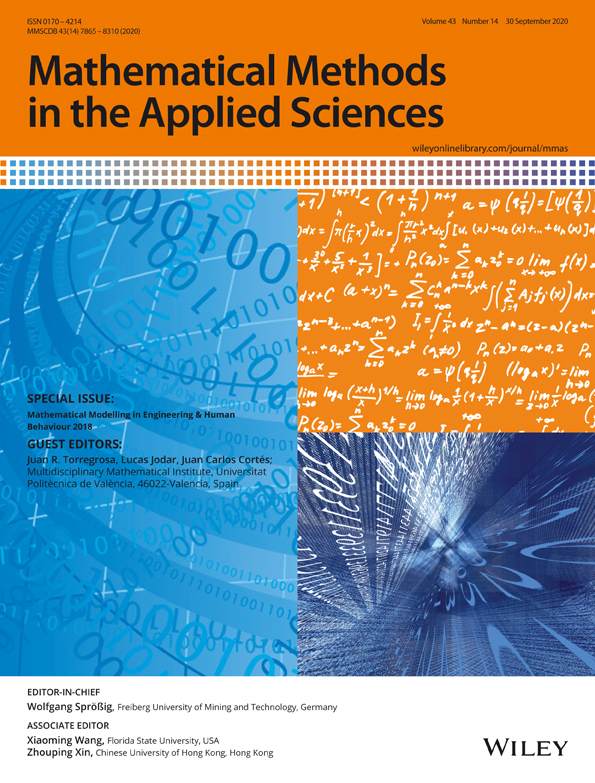Integral transform solution of random coupled parabolic partial differential models
Corresponding Author
María Consuelo Casabán
Instituto de Matemática Multidisciplinar, Universitat Politècnica de València, Valencia, Spain
Correspondence
María Consuelo Casabán, Instituto de Matemática Multidisciplinar, Universitat Politècnica de València, Camino de Vera, s/n, 46022 Valencia, Spain.
Email: [email protected]
Communicated by: J. R. Torregrosa
Search for more papers by this authorRafael Company
Instituto de Matemática Multidisciplinar, Universitat Politècnica de València, Valencia, Spain
Search for more papers by this authorVera N. Egorova
Departamento de Matemática Aplicada y Ciencias de la Computació, Universidad de Cantabria, Santander, Spain
Search for more papers by this authorLucas Jódar
Instituto de Matemática Multidisciplinar, Universitat Politècnica de València, Valencia, Spain
Search for more papers by this authorCorresponding Author
María Consuelo Casabán
Instituto de Matemática Multidisciplinar, Universitat Politècnica de València, Valencia, Spain
Correspondence
María Consuelo Casabán, Instituto de Matemática Multidisciplinar, Universitat Politècnica de València, Camino de Vera, s/n, 46022 Valencia, Spain.
Email: [email protected]
Communicated by: J. R. Torregrosa
Search for more papers by this authorRafael Company
Instituto de Matemática Multidisciplinar, Universitat Politècnica de València, Valencia, Spain
Search for more papers by this authorVera N. Egorova
Departamento de Matemática Aplicada y Ciencias de la Computació, Universidad de Cantabria, Santander, Spain
Search for more papers by this authorLucas Jódar
Instituto de Matemática Multidisciplinar, Universitat Politècnica de València, Valencia, Spain
Search for more papers by this authorAbstract
Random coupled parabolic partial differential models are solved numerically using random cosine Fourier transform together with non-Gaussian random numerical integration that captures the highly oscillatory behaviour of the involved integrands. Sufficient condition of spectral type imposed on the random matrices of the system is given so that the approximated stochastic process solution and its statistical moments are numerically convergent. Numerical experiments illustrate the results.
CONFLICT OF INTEREST
The authors declare that there is no conflict of interest regarding the publication of this article.
REFERENCES
- 1Bäck J, Nobile F, Tamellini L, Tempone R. Stochastic spectral galerkin and collocation methods for PDEs with random coefficients: a numerical comparison. In: J Hesthaven, E Rønquist, eds. Spectral and High Order Methods for Partial Differential Equations, Lecture Notes in Computational Science and Engineering. Vol 76. Berlin, Heidelberg: Springer; 2011.
10.1007/978-3-642-15337-2_3 Google Scholar
- 2Bachmayr M, Cohen A, Migliorati G. Sparse polynomial approximation of parametric elliptic PDEs. Part I: affine coeff ESAIM M2AN. 2017; 51(1): 321–339.
10.1051/m2an/2016045 Google Scholar
- 3Ernst O, Sprungk B, Tamellini L. Convergence of sparse collocation for functions of countably many Gaussian random variables (with application to elliptic PDEs). SIAM J Num Anal. 2018; 56(2): 877–905.
- 4Sheng D, Axelsson K. Uncoupling of coupled flows in soil-a finite element method. Int J Num Anal Met Geomech. 1995; 19(8): 537–553.
- 5Mitchell JK. Conduction phenomena: from theory to geotechnical practice. Géotechnique. 1991; 41(3): 299–340.
- 6Metaxas AC, Meredith RJ. Institution of Electrical Engineers. Industrial microwave heating, Peter Peregrinus Ltd. on behalf of the Institution of Electrical Engineers. London; 1983.
- 7Das PK. Optical Signal Processing. Berlin Heidelberg:Springer-Verlag; 1991.
10.1007/978-3-642-74962-9 Google Scholar
- 8Ekman VW. On the influence of the Earth's rotation on ocean-currents. Arkiv for Matematik. Astronomi och Fysik. 1905; 2(11): 1–52.
- 9Yosef AHG, Bel G. Energy transfer of surface wind-induced currents to the deep ocean via resonance with the Coriolis force. J Marine Syst. 2017; 167: 93–104.
- 10Stacey Weston M. Fusion Plasma Analysis:John Wiley & Sons Inc; 1981.
- 11Hodgkin AL, Huxley AF. A quantitative description of membrane current and its application to conduction and excitation in nerve. J Phys. 1952; 117(4): 500–544.
- 12Winfree AT. When Time Breaks Down: The Three-Dimensional Dynamics of Electrochemical Waves and Cardiac Arrhythmias. Princeton, NJ, USA: Princeton University Press; 1987.
- 13Galiano G. On a cross-diffusion population model deduced from mutation and splitting of a single species. Comput Math Appl. 2012; 64(6): 1927–1936.
- 14Casabán MC, Company R, Jódar L. Numerical solutions of random mean square Fisher–KPP models with advection. Math Methods Appl Sci. 2019.
- 15Casabán MC, Company R, Jódar L. Numerical integral transform methods for random hyperbolic models with a finite degree of randomness. Math. 2019; 7(9): 853.
10.3390/math7090853 Google Scholar
- 16Shampine LF. Vectorized adaptive quadrature in MATLAB. J Comput Appl Math. 2008; 211(2): 131–140.
- 17Iserles A. On the numerical quadrature of highly-oscillating integrals I: Fourier transforms. IMA J Num Anal. 2004; 24(3): 365–391.
- 18Ma J, Liu H. On the convolution quadrature rule for integral transforms with oscillatory Bessel kernels. Symmetry. 2018; 10(7).
- 19Jódar L, Goberna D. Exact and analytic numerical solution of coupled diffusion problems in a semi-infinite medium. Comput Math Appl. 1996; 31(9): 17–24.
- 20Jódar L, Goberna D. A matrix D'Alembert formula for coupled wave initial value problems. Comp Math Appl. 1998; 35(9): 1–15.
- 21Davis PJ, Rabinowitz P. Computer Science and Applied Mathematics. San Diego:Academic Press, Inc.; 1984.
- 22Dahlquist G. Stability and Error Bounds in the Numerical Integration of Ordinary Differential Equations. Stockholm:Almqvist & Wiksells; 1958.
- 23Ostrowski AM. A quantitative formulation of Sylvester's law of inertia. Proc Nat Acad Sci Unit Stat Amer. 1959; 45(5): 740–44.
- 24 The MathWorks Inc.. Matlab (R2019b). Natick, Massachusetts:The Mathworks, Inc.; 2019.
- 25Yosef AHG, Bel G. The effect of stochastic wind on the infinite depth Ekman layer model. EPL. 2015; 111(3): 39001.
- 26 Wolfram Research Inc. Mathematica, Version 11.3. Champaign, United States; 2018.
Citing Literature
Special Issue:Mathematical Modelling in Engineering & Human Behaviour 2018
30 September 2020
Pages 8223-8236




